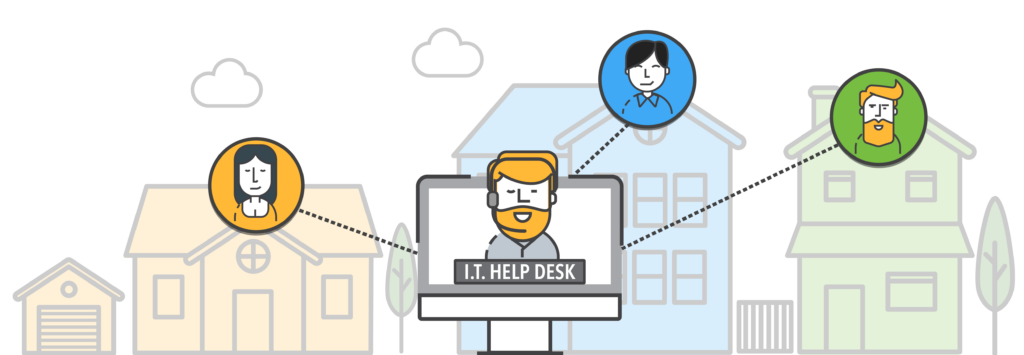How can IT help everybody who’s working from home?

With the sudden, urgent shift to work from home that began in March and the current likelihood that many will continue to work remotely, IT and help desk staff are expanding into new territory. Instead of just on-premise-support, now your IT team is also supporting dozens, hundreds, or even thousands of home offices, each with its own quirks, unique configurations, and unknown hardware.
One of the challenges with supporting remote workers is that they still need to hold meetings, and with today’s amazing advances in internet telephony and video conferencing, using video chat is becoming the new norm. In addition to video conferencing, there are many other business applications vying for support and bandwidth, from file sharing to database access to remote desktops to VPNs. Residential internet connections were not built to simultaneously handle this type of traffic alongside gaming and streaming services all day, especially when aggregated across entire neighborhoods and even rural areas filled with at-home workers.
Supporting home office network connections
Home offices face a number of internet connection challenges. Due to the asymmetry of residential bandwidth, home office network connections tend to have low upstream throughput. Business applications are definitely competing with residential bulk data for their share of that coveted home internet connection.
The wide variety of network devices being used by at-home workers will make it challenging for the IT support staff to be familiar with every configuration and every option available. In this situation, you are reduced to guiding non-technical workers through ping tests over the phone and urging your coworkers to go thumbing through manuals in hopes of finding helpful support information. This is not an ideal situation and is bound to be frustrating for all parties involved.
A configuration option that may be available for remote workers in their home network is Quality of Service, or QoS. This will configure traffic shaping at the network device and can hopefully be used to give priority to specific types of traffic. However, it is important to remember that in residential routers and access points, the QoS settings will typically be limited. It may just be an on/off toggle switch.
Residential hardware is not typically good at identifying a variety of traffic types, which means that while it’s possible to turn QoS support on, it might not actually be addressing the problem. However, some do implement device-level prioritization by MAC or IP address. When available, this could be useful for favoring the work computer over the kid’s tablet.
If the router does have more detailed QoS configuration options, a certain level of technical know-how will likely be needed to make those policy changes. Whether the options are basic or more complex, it’s likely that each of your home workers is using a different model of router and different hardware to connect to the internet. This means IT would have to support an array of devices with different capabilities.
Advanced solutions for the home office
Since the QoS solutions in residential hardware are typically limited, the first solution to come to mind might be to use existing enterprise hardware and repurpose it for the home office. In order for a QoS solution to be able to prioritize business traffic over residential traffic, it needs to be able to do these three things:
- Identify the source and type of network traffic.
- Synchronize information across devices.
- Be aware of the total amount of bandwidth available – in both directions.
Most traditional enterprise QoS solutions can handle the first two requirements just fine, but many don’t have the ability to be aware of throughput or network capacity. They are designed for the consistent business connection, not the shared, fluctuating residential connection. This limits the effectiveness of their traffic shaping capabilities for a residential service.
Fortunately, there are newer QoS technologies such as Bigleaf Network’s Dynamic QoS, which automatically identifies and and applies automated QoS policies to ensure business app traffic is prioritized over other household traffic. Bigleaf also monitors constantly shifting broadband capacity in real time to adjust traffic before key applications drop or lag.
Bigleaf is committed to helping organizations provide their employees with reliable communications, internet access, and application performance in their home offices. Bigleaf Home Office can keep the chaos and unpredictability of residential Internet connections from impacting business communications and applications.
With an easy plug-in, no manual-configuration installation users can do themselves, Bigleaf Home Office can be easily deployed across your team’s home offices. A Bigleaf edge router is sent directly to each home office, and the typical install simply requires it to be plugged in to the existing ISP modem and to a WiFi router without the need for specialized IT resources. The set up works seamlessly with existing ISP and broadband connections, supporting both single and multiple circuits.
Alongside QoS, Bigleaf Home Office offers software-defined networking (SD-WAN) with support for redundant network connections and outage detection outside the home network. Bigleaf utilizes its nationwide Cloud Access Network and gateway clusters to ensure a high-performance connection to the Cloud. You can also remotely view and manage the health of the home office network with the Bigleaf online dashboard, which will make troubleshooting infinitely faster.
Learn more about Bigleaf Home Office.







